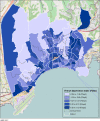Impact of social and demographic factors on the spread of the SARS-CoV-2 epidemic in the town of Nice
- PMID: 37280635
- PMCID: PMC10243248
- DOI: 10.1186/s12889-023-15917-z
Impact of social and demographic factors on the spread of the SARS-CoV-2 epidemic in the town of Nice
Abstract
Introduction: Socio-demographic factors are known to influence epidemic dynamics. The town of Nice, France, displays major socio-economic inequalities, according to the National Institute of Statistics and Economic Studies (INSEE), 10% of the population is considered to live below the poverty threshold, i.e. 60% of the median standard of living.
Objective: To identify socio-economic factors related to the incidence of SARS-CoV-2 in Nice, France.
Methods: The study included residents of Nice with a first positive SARS-CoV-2 test (January 4-February 14, 2021). Laboratory data were provided by the National information system for Coronavirus Disease (COVID-19) screening (SIDEP) and socio-economic data were obtained from INSEE. Each case's address was allocated to a census block to which we assigned a social deprivation index (French Deprivation index, FDep) divided into 5 categories. For each category, we computed the incidence rate per age and per week and its mean weekly variation. A standardized incidence ratio (SIR) was calculated to investigate a potential excess of cases in the most deprived population category (FDep5), compared to the other categories. Pearson's correlation coefficient was computed and a Generalized Linear Model (GLM) applied to analyse the number of cases and socio-economic variables per census blocks.
Results: We included 10,078 cases. The highest incidence rate was observed in the most socially deprived category (4001/100,000 inhabitants vs 2782/100,000 inhabitants for the other categories of FDep). The number of observed cases in the most social deprivated category (FDep5: N = 2019) was significantly higher than in the others (N = 1384); SIR = 1.46 [95% CI:1.40-1.52; p < 0.001]. Socio-economic variables related to poor housing, harsh working conditions and low income were correlated with the new cases of SARS-CoV-2.
Conclusion: Social deprivation was correlated with a higher incidence of SARS-CoV-2 during the 2021 epidemic in Nice. Local surveillance of epidemics provides complementary data to national and regional surveillance. Mapping socio-economic vulnerability indicators at the census block level and correlating these with incidence could prove highly useful to guide political decisions in public health.
Trial registration: ClinicalTrials.gov NCT05379621.
Keywords: COVID-19; Incidence; Risk factors; Social inequalities.
© 2023. The Author(s).
Conflict of interest statement
The authors declare no competing interests.
Figures





Similar articles
-
Spatial distribution of SARS-CoV-2 incidence, social inequality, housing conditions, and density in South-Eastern France: keys for future epidemics.Front Public Health. 2024 Dec 6;12:1422112. doi: 10.3389/fpubh.2024.1422112. eCollection 2024. Front Public Health. 2024. PMID: 39712297 Free PMC article.
-
The effect of social deprivation on the dynamic of SARS-CoV-2 infection in France: a population-based analysis.Lancet Public Health. 2022 Mar;7(3):e240-e249. doi: 10.1016/S2468-2667(22)00007-X. Epub 2022 Feb 15. Lancet Public Health. 2022. PMID: 35176246 Free PMC article.
-
Social deprivation and SARS-CoV-2 testing: a population-based analysis in a highly contrasted southern France region.Front Public Health. 2023 May 12;11:1162711. doi: 10.3389/fpubh.2023.1162711. eCollection 2023. Front Public Health. 2023. PMID: 37250096 Free PMC article.
-
SARS-CoV-2 pandemic and Construction Industry: insights from Italian data.Acta Biomed. 2022 Jul 1;93(3):e2022233. doi: 10.23750/abm.v93i3.12265. Acta Biomed. 2022. PMID: 35775779 Free PMC article.
-
A Review of Influencing Factors on Spatial Spread of COVID-19 Based on Geographical Perspective.Int J Environ Res Public Health. 2021 Nov 20;18(22):12182. doi: 10.3390/ijerph182212182. Int J Environ Res Public Health. 2021. PMID: 34831938 Free PMC article.
Cited by
-
Temporal trends in disparities in COVID-19 seropositivity among Canadian blood donors.Int J Epidemiol. 2024 Apr 11;53(3):dyae078. doi: 10.1093/ije/dyae078. Int J Epidemiol. 2024. PMID: 38840559 Free PMC article.
-
Spatial distribution of SARS-CoV-2 incidence, social inequality, housing conditions, and density in South-Eastern France: keys for future epidemics.Front Public Health. 2024 Dec 6;12:1422112. doi: 10.3389/fpubh.2024.1422112. eCollection 2024. Front Public Health. 2024. PMID: 39712297 Free PMC article.
References
-
- Département de Santé Publique CHU Nice, Délégation Alpes-Maritimes Agence Régionale de la Santé. Bulletin départemental d’information COVID-19. 2020.
-
- Santé Publique France. Données de laboratoires pour le dépistage (A COMPTER DU 18/05/2022) - SI-DEP. Data.gouv.fr. 2023. Avaiable at: https://static.data.gouv.fr/resources/donnees-de-laboratoires-pour-le-de....
-
- Santé Publique France. COVID-19: Point épidémiologique hebdomadaire du 14 janvier 2021. Available at sur: https://www.santepubliquefrance.fr/maladies-et-traumatismes/maladies-et-....
-
- Santé Publique France. COVID-19: Point épidémiologique hebdomadaire du 18 février 2021. Available at : https://www.santepubliquefrance.fr/maladies-et-traumatismes/maladies-et-....
MeSH terms
Associated data
LinkOut - more resources
Full Text Sources
Medical
Miscellaneous

